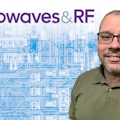The marriage of digital technologies and RF is a done deal, leaving designers with a need for increased information bandwidth and accurate phase and magnitude characterization of extremely wideband signals. Applications such as radar target classification, satellite communications, frequency-agile communications, and spectrum management are prime examples of areas where traditional analysis tools aren’t cutting the mustard any longer.
So rather than stick with the tried-and-true approach of using a wideband digital scope and a lot of post-processing of wideband RF signals, Tektronix has taken a decidedly modern tack with its SignalVu vector signal analysis software (see the figure). The software, which is available as an option for the DPO7000 and DPO/DSA70000 digital scopes, effectively transforms the instruments into a vector-signal analyzer and/or a spectrum analyzer, while retaining the scopes’ powerful triggering capabilities.
“The dominant use case for making wideband RF measurements has been using scopes as data loggers,” says Jim Taber, senior product planner for Tektronix’s real-time spectrum analyzer line. “They capture a time-domain waveform, output the log, and then do it again and again. This measurement loop takes time, and if you don’t collect the right information, you end up starting over.”
The SignalVu software takes the same analysis software that’s on Tektronix’s real-time spectrum analyzers and puts it onto the DPO7000 and DPO/DSA70000 scopes. This enables users to make traditional spectrum-analyzer measurements, using the scopes as they would a vector spectrum analyzer. It provides time-correlated markers for easy correlation of the time and frequency domains, as well as automatic characterization of pulses.
Taking advantage of the scopes’ real-time bandwidth of 20 GHz and sampling rates of 50 µs, SignalVu allows users to dial in the portion of signals they want to see, zooming in on slices of spectrum and examining them in great detail.
SignalVu enables the scopes to display the data in a very usable manner. It provides a time-overview display, showing power over time. It also provides a spectrum view as well as a spectrogram. Capturing a signal once enables it to be replayed and viewed in many different contexts. Users can place a correlated marker on the signal in any given view that is reflected in other domains.
Inside the SignalVu interface, users can trigger on time- and amplitude-varying events; there are some 1400 different unique triggering combinations. A single acquisition can then be analyzed in multiple ways. SignalVu’s acquisition capabilities are limited only by the scope’s internal memory. “You have essentially a four-channel spectrum analyzer,” says Tektronix’s Jim Taber. “You can apply math to any of the channels and can combine, filter, or integrate signals.” Users can also pre-process the waveform before SignalVu does its own processing.
The analysis capabilities of the software combined with the scopes’ capabilities have several facets that lend themselves to various applications in which wideband RF plays a dominant role. For example, for analysis of frequency-agile radios, the software’s timing resolution enables users to create frequency versus time plots that show where one frequency hop ends and the next one starts. And when it comes to analysis of wideband radar, the scopes’ 20-GHz bandwidth enables direct measurement of Ku-band signals without need for a downconverter.
The SignalVu/scope combination comprises a fully integrated package. All of the scopes’ memory is available for acquisition. Further, the scopes’ user interface and the SignalVu user interface are peers, meaning that the SignalVu user interface is simply an alternative to that of the scope. “You don’t have to run the scope’s software unless you want to take advantage of the triggering,” says Taber. SignalVu allows changing of reference levels or sample rates from the scopes’ front panels.
SignalVu comes in three basic flavors. One is for the DPO7000 Series scopes for bandwidths between 500 MHz and 3.5 GHz ($3490). The other two are for the DPO/DSA70000 Series scopes for the ranges of 4 GHz to 8 GHz ($4990) and 12.5 GHz to 20 GHz ($6990). There’s also application-support packages for wideband radar ($6420) and general-purpose modulation analysis for wideband communications ($5450). The latter are over and above the basic flavors and must be purchased in addition to the basic SignalVu software that’s appropriate for your model scope. The software is available now.
Tektronix Inc.
www.tektronix.com
